
3D Printing For Dummies
Published by: John Wiley & Sons, Inc., 111 River Street, Hoboken, NJ 07030-5774, www.wiley.com
Copyright 2014 by John Wiley & Sons, Inc., Hoboken, New Jersey
Published simultaneously in Canada
No part of this publication may be reproduced, stored in a retrieval system or transmitted in any form or by any means, electronic, mechanical, photocopying, recording, scanning or otherwise, except as permitted under Sections 107 or 108 of the 1976 United States Copyright Act, without the prior written permission of the Publisher. Requests to the Publisher for permission should be addressed to the Permissions Department, John Wiley & Sons, Inc., 111 River Street, Hoboken, NJ 07030, (201) 748-6011, fax (201) 748-6008, or online at http://www.wiley.com/go/permissions .
Trademarks: Wiley, For Dummies, the Dummies Man logo, Dummies.com, Making Everything Easier, and related trade dress are trademarks or registered trademarks of John Wiley & Sons, Inc. and may not be used without written permission. All other trademarks are the property of their respective owners. John Wiley & Sons, Inc. is not associated with any product or vendor mentioned in this book.
LIMIT OF LIABILITY/DISCLAIMER OF WARRANTY: THE PUBLISHER AND THE AUTHOR MAKE NO REPRESENTATIONS OR WARRANTIES WITH RESPECT TO THE ACCURACY OR COMPLETENESS OF THE CONTENTS OF THIS WORK AND SPECIFICALLY DISCLAIM ALL WARRANTIES, INCLUDING WITHOUT LIMITATION WARRANTIES OF FITNESS FOR A PARTICULAR PURPOSE. NO WARRANTY MAY BE CREATED OR EXTENDED BY SALES OR PROMOTIONAL MATERIALS. THE ADVICE AND STRATEGIES CONTAINED HEREIN MAY NOT BE SUITABLE FOR EVERY SITUATION. THIS WORK IS SOLD WITH THE UNDERSTANDING THAT THE PUBLISHER IS NOT ENGAGED IN RENDERING LEGAL, ACCOUNTING, OR OTHER PROFESSIONAL SERVICES. IF PROFESSIONAL ASSISTANCE IS REQUIRED, THE SERVICES OF A COMPETENT PROFESSIONAL PERSON SHOULD BE SOUGHT. NEITHER THE PUBLISHER NOR THE AUTHOR SHALL BE LIABLE FOR DAMAGES ARISING HEREFROM. THE FACT THAT AN ORGANIZATION OR WEBSITE IS REFERRED TO IN THIS WORK AS A CITATION AND/OR A POTENTIAL SOURCE OF FURTHER INFORMATION DOES NOT MEAN THAT THE AUTHOR OR THE PUBLISHER ENDORSES THE INFORMATION THE ORGANIZATION OR WEBSITE MAY PROVIDE OR RECOMMENDATIONS IT MAY MAKE. FURTHER, READERS SHOULD BE AWARE THAT INTERNET WEBSITES LISTED IN THIS WORK MAY HAVE CHANGED OR DISAPPEARED BETWEEN WHEN THIS WORK WAS WRITTEN AND WHEN IT IS READ.
For general information on our other products and services, please contact our Customer Care Department within the U.S. at 877-762-2974, outside the U.S. at 317-572-3993, or fax 317-572-4002. For technical support, please visit www.wiley.com/techsupport .
Wiley publishes in a variety of print and electronic formats and by print-on-demand. Some material included with standard print versions of this book may not be included in e-books or in print-on-demand. If this book refers to media such as a CD or DVD that is not included in the version you purchased, you may download this material at http://booksupport.wiley.com . For more information about Wiley products, visit www.wiley.com .
Library of Congress Control Number: 2013952422
ISBN 978-1-118-66075-1 (pbk); ISBN 978-1-118-66077-5 (ebk); ISBN 978-1-118-66068-3 (ebk)
Manufactured in the United States of America
10 9 8 7 6 5 4 3 2 1
Chapter 1
Seeing How 3D Printers Fit into Modern Manufacturing
In This Chapter
 Embracing additive manufacturing
Embracing additive manufacturing
 Defining additive manufacturing
Defining additive manufacturing
 Contrasting traditional manufacturing
Contrasting traditional manufacturing
 Recycling and planned obsolescence
Recycling and planned obsolescence
 Exploring the application of 3D printing
Exploring the application of 3D printing
A n amazing transformation is currently under way in manufacturing, across nearly all types of products a transformation that promises to remake the future into a sustainable and personally customized environment. In this fast-approaching future, everything we need from products to food, and even our bodies themselves can be replaced or reconstructed rapidly and with very minimal waste. This is not the slow change of progress from one generation of iPhone to the next, but instead a true revolution, mirroring the changes that introduced the world to the Industrial Age and then bought light and electricity to our homes and businesses.
This will not be a bloodless coup by any means; any truly fundamental change that spans all aspects of the global economy will, by its nature, be disruptive. But traditional inefficient ways of producing the next year's model will surely give way to entirely new opportunities impossible to imagine before. The technology behind this transformation is referred to as additive manufacturing, 3D printing, or direct digital manufacturing.
By whatever name, in the coming decade this technology will be used to construct everything from houses to jet engines, airplanes, food, and even replacement tissues and organs made from your own cells! Every day new applications of 3D printing are being discovered and developed all over the world. And even in space: NASA is testing designs that will function in zero gravity, on the airless moon, and even to support human exploration of other planets like Mars. (See Figure for a glimpse.) Hold on tight, because in the chapters ahead we cover a lot of incredibly new and fantastic technologies and before the end, we show you how you can get involved in this amazing transformation yourself by building and using a 3D printer at home.
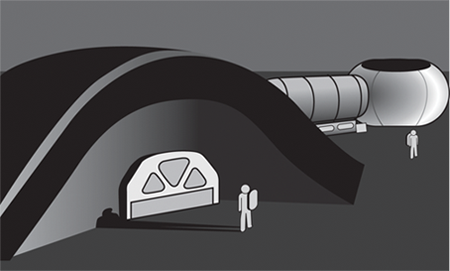
Figure 1-1: A line drawing of NASA's planned 3D-printed lunar construction.
Embracing Additive Manufacturing
So, what is additive manufacturing, you might ask? Additive manufacturing is a little like the replicators in the Star Trek universe, which allow the captain to order Tea, Earl Grey, hot and have a cup filled with liquid appear fully formed and ready for consumption. We are not quite to that level, but today's 3D printers perform additive manufacturing by taking a 3D model of a object stored in a computer, translating it into a series of very thin layers, and then building the object one layer at a time, stacking up material until the object is ready for use.
 3D printers are much like the familiar desktop printer you already use at work or in your home to create copies of documents transmitted electronically or created on your computer, except that a 3D printer creates a solid three-dimensional object out of a variety of materials, not just a simple paper document.
3D printers are much like the familiar desktop printer you already use at work or in your home to create copies of documents transmitted electronically or created on your computer, except that a 3D printer creates a solid three-dimensional object out of a variety of materials, not just a simple paper document.
Since the time of Johannes Gutenberg, creating multiple printed documents has brought literacy to the world. Today, when you click the Print button in a word processor application, you merge the functions of writers, stenographers, editors (spellcheck), layout, illumination (coloring and adding in images), and press reproduction all into a single task, and with the click of a few more buttons, you can post the document you create onto the Internet and allow it to be shared, downloaded, and printed out by others all over the world.


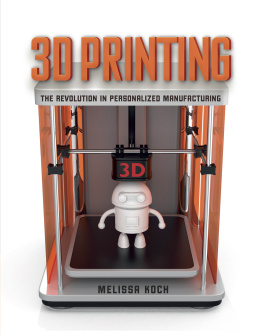

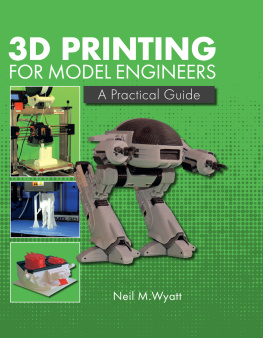
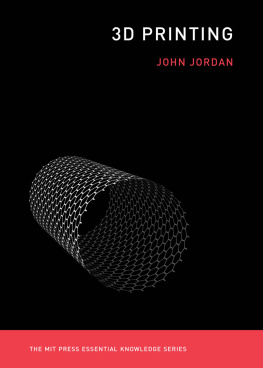
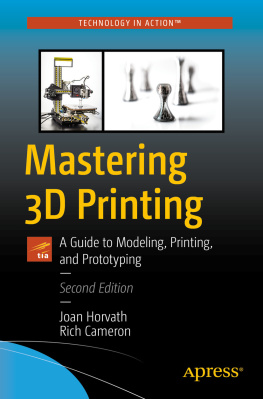
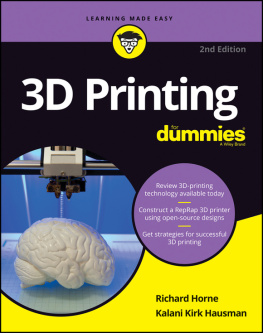

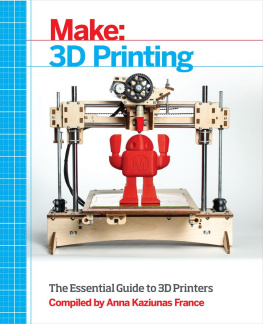
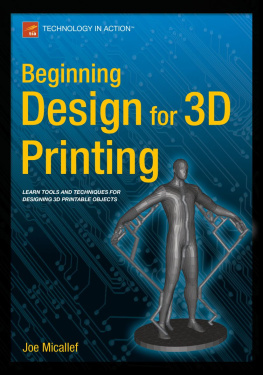
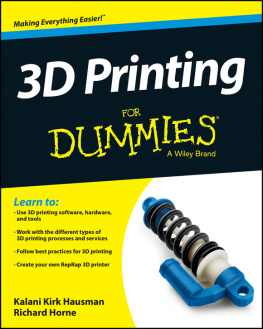
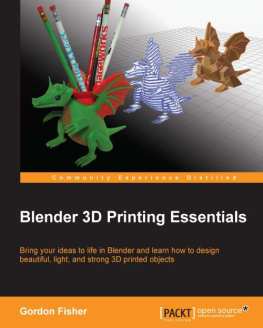

 Embracing additive manufacturing
Embracing additive manufacturing
 3D printers are much like the familiar desktop printer you already use at work or in your home to create copies of documents transmitted electronically or created on your computer, except that a 3D printer creates a solid three-dimensional object out of a variety of materials, not just a simple paper document.
3D printers are much like the familiar desktop printer you already use at work or in your home to create copies of documents transmitted electronically or created on your computer, except that a 3D printer creates a solid three-dimensional object out of a variety of materials, not just a simple paper document.